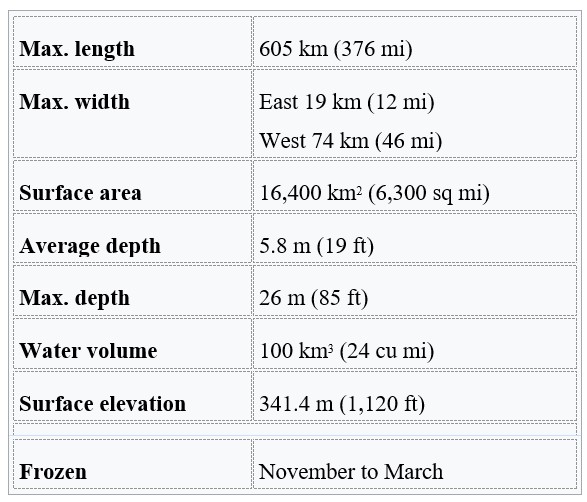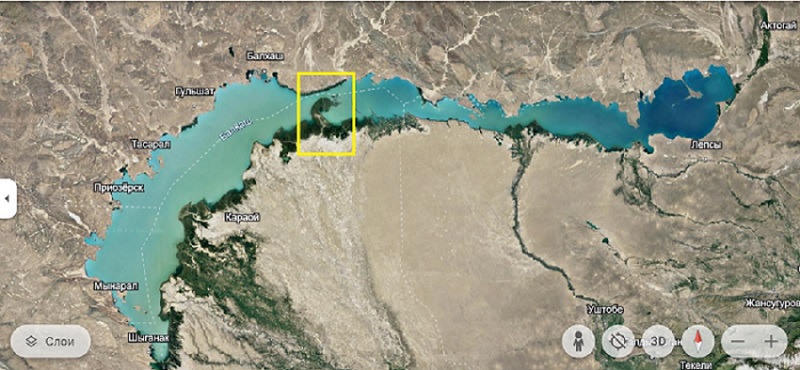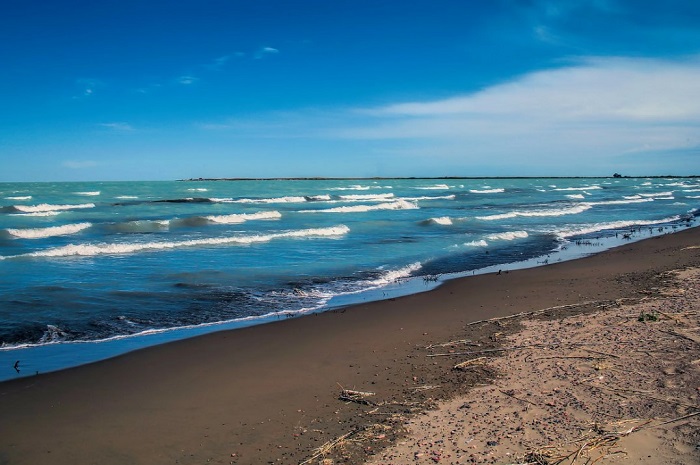nCa Commentary
Lake Balkhash is located in southeastern Kazakhstan. It is one of the largest lakes in Asia and the 15th largest in the world.
The basin drains seven rivers, the primary of which is the Ili, bringing most of the riparian inflow; others, such as the Karatal, bring surface and subsurface flow. The Ili is fed by precipitation, largely vernal snowmelt, from the mountains of China’s Xinjiang region.
The lake currently covers about 16,400 km2 (6,300 sq mi). However, like the Aral Sea, it is shrinking due to diversion and extraction of water from its feeders.
 The lake’s western part is fresh water and its eastern half is saline.
The lake’s western part is fresh water and its eastern half is saline.
There is concern about the lake’s shallowing due to desertification of microclimates and water extraction for multiplied industrial output. Moreover, the impacts of climate change may also negatively affect the lake and its ecosystems.
As recently as 1910 the lake was considerably larger with an estimated area of 23,464 km2. By 1946 this had shrunk to 15,730 km2.
The lake covers about 16,400 km2 (2000),[3] making it the largest lake wholly in Kazakhstan. Its surface is about 340 m above sea level.
The Balkhash-Alakol Basin covers 512,000 km2, and its average surface water runoff is 27.76 km3/year, of which 11.5 km3 comes from China. The drainage basin of the lake is about 413,000 km2; with 15% in the north-west of Xinjiang in China and a negligible part from mountains along the Kyrgyz-Kazakh border. Lake Balkhash thus takes 86% of water inflow from Balkhash-Alakol basin.
The lake used to have a rich fauna, but since 1970, biodiversity began to decline due to deterioration of water quality.
Abundant and dense reeds in the southern part of the lake, especially in the delta of the Ili River, served as a haven for birds and animals. Changes in the water level led to the degradation of the delta – since 1970, its area decreased from 3,046 to 1,876 km2, reducing wetlands and riparian forests which were inhabited by birds and animals.
Land development, application of pesticides, overgrazing and deforestation also contributed to the decrease in biodiversity. Of the 342 species of vertebrates, 22 are endangered and are listed in the Red Book of Kazakhstan.
Forests of the Ili delta were inhabited by the rare Caspian tiger and its prey, wild boar.
Around the 1940s, Canadian muskrat was brought to the Ili delta; it quickly acclimatized, feeding on Typha, and was trapped for fur, up to 1 million animals per year. However, recent changes in the water level destroyed its habitat, bringing the fur industry to a halt.
The economic importance of the lake itself is mostly in its fishing industry. Systematic breeding of fish began in 1930; the annual catch was 20 thousand tonnes in 1952, it increased to 30 thousands in the 1960s and included up to 70% of valuable species. However, by the 1990s production fell to 6,600 tonnes per year with only 49 tonnes of valuable breeds. The decline is attributed to several factors, including the halt of reproduction programs, poaching and decline in water level and quality.
Reduction in the water volume in the lake is partly because its main tributary, the Ili River serves a hydropower plant at Kapshagay and cotton farming in Chinese province of Xinjiang. The diversion of water from the Ili Rivr will increase with more hydropower projects in the pipeline.
There are fears that with unchecked deterioration, the fate of the Lake Balkhash could be similar to the fate of the Aral Sea.
Of the 16 existing lake systems around the lake only five remain. The desertification process involved about 1⁄3 of the basin. Salt dust is blown away from the dried areas, contributing to the generation of Asian dust storms, increase the soil salinity and adversely influencing the climate.
Another factor affecting the ecology of the Ili-Balkhash basin is emissions due to mining and metallurgical processes, mostly at the Balkhash Mining and Metallurgy Plant operated by Kazakhmys. In the early 1990s, the emission level was 280–320 thousand tonnes per year, depositing 76 tonnes of copper, 68 tonnes of zinc and 66 tonnes of lead on the surface of the lake. Since then, emissions have almost doubled. Contaminants are also brought from the dump sites by the dust storms.
Kazakhstan has tried to reverse the decline in the lake situation but the efforts, at best, remain sporadic.
The planned nuclear power plant at the lake is also a source of controversy.
In 2013, McKinsey consulting firm prepared a model of ‘green’ development of Kazakhstan by order of the government. The document contained, among others, the research of the Balkhash basin issues, reports CABAR.asia.
“McKinsey calculated that Lake Balkhash would have a water shortage of 1.9 billion cubic meters in 2030 given the existing situation, which is catastrophic for the lake,” said Bulat Yesekin , expert in ecopolitics, climate and water resources. “According to their statement, it would cause the irreversible degradation of the lake, in other words, it would be impossible to recover the lake ecosystem, one of the largest on the planet.”
According to Yesekin, if urgent measures are not taken today, Kazakhstan will face another environmental disaster right in the center of the country with all the consequences that are known from the Aral Sea: water shortage, exhaustion of land, increase in noxious emissions, migration and conflicts.
Other researches show that the key obstacle to stopping a wasteful use of water is the fragmented management system.
“We also need a special law on Lake Balkhash with legal confirmation of critical parameters and incentives needed to preserve the basin ecosystem,” the expert said.
“The ecosystem of Lake Balkhash plays a role of the main natural regulator of the balance across the Balkhash-Alakol basin, maintaining the circulation and exchange of water, nutrients, energy and other vital natural processes,” Bulat Yesekin said.
Climate change aggravates the situation with the lake. According to scientists , Central Asia gets warmer faster than other regions of the world. Therefore, the problems of Balkhash would aggravate every year and affect all countries of the region.
“Every new load would only compound the situation,” Yesekin said.
A NPP is the new load because it is a large water user and a great thermal pollution. Balkhash is not a very deep lake, its average depth is six meters, and the rise in water temperature may be critical for the lake.
“A nuclear power plant needs a large amount of water for heat exchange and cooling,” a scientist, who wished to remain anonymous because the subject of a nuclear power plant in Kazakhstan academic community is quite sensitive, said to CABAR.asia. “Withdrawal of a large amount of water from the lake will certainly have a negative impact on the basin balance and the balance of the Ili-Balkhash basin in general.”
 The screenshot of earth.google shows the Uzyn-Aral Strait on Lake Balkhash. Bulat Yesekin, expert in water resources, told us the following: “My acquaintance who flew from Astana to Almaty, said that this year it is obvious from the plane that the lake is being divided into two parts. Therefore, it should not be allowed to increase the load on the ecosystem, and the existing load should be decreased.”
The screenshot of earth.google shows the Uzyn-Aral Strait on Lake Balkhash. Bulat Yesekin, expert in water resources, told us the following: “My acquaintance who flew from Astana to Almaty, said that this year it is obvious from the plane that the lake is being divided into two parts. Therefore, it should not be allowed to increase the load on the ecosystem, and the existing load should be decreased.”
The point is that the main water artery feeding Balkhash is the Ili River, whose delta flows into the western section of the lake. The Karatal, Asu, Lepsy Rivers fall into the eastern section. Nevertheless, the balance is generally maintained by the overflow of water from the western section to the eastern one via the Uzyn-Aral Strait.
“Construction of the nuclear power plant as a major water user, which will withdraw large amounts of water from the lake, will disturb its balance. It can lead to full degradation of the ecosystem of Balkhash and destruction of the flora and fauna habitat,” the anonymous speaker said.
“The comparison of the amounts of water withdrawal for the NPP (63 million cubic meters) with the rate of lake surface evaporation made up by nuclear lobbyists is incorrect, and actually ridiculous. Water evaporation is an important part of the natural process that maintains the balance and health of the basin, while the water withdrawal and pollution by the NPP disturb them,” Yesekin said.
The fate of Balkhash also depends on the actions of China. The River Ili, the main source of water in the lake, starts in the Xinjiang Uyghur Autonomous Region of the People’s Republic of China. Every year the water withdrawal rate from Ili rises because the number of people living in the region increases.
“If the water flow from China was almost 14 cubic kilometres 10 years ago, now it is below 10 cubic kilometres. Moreover, we do not have any agreements on maintaining the cross-boundary flow with China,” Bulat Yesekin emphasized the problem and reminded that there was a precedent in the Balkhash history when the Chinese party had almost left the lake without water.
It happened due to the construction of the Kapshagai Reservoir. It was formed by blocking the flow of River Ili in Kapshagai Gorge, which allowed to build the HPP and provide electricity to Almaty. While the reservoir was filled, the water level of Balkhash declined: a small salt lake of Alakol almost vanished from 1972 to 2001, it is located 8 kilometers southward of Balkhash. The southern section of Balkhash lost up to 150 square kilometers of its surface.
Kazakhstan and France are exploring the possibility of joint research on Lake Balkhash, reports Daryo news service of Uzbekistan.
A collaborative project, initiated last year, has seen significant progress with eight workshops conducted in Kazakhstan, attended by French experts. The objective has been to identify and address critical issues in groundwater management.
There is the proposal for a comprehensive study of the Lake Balkhash basin, aiming to formulate a model for its water resource management. This endeavor entails satellite image analysis and hydrogeological assessments. If realized, the French Development Agency is expected to contribute to this research initiative.
The attention being paid so far to Lake Balkhash is not proportional to the challenges facing it. More needs to be done, sooner. /// nCa, 27 June 2024
